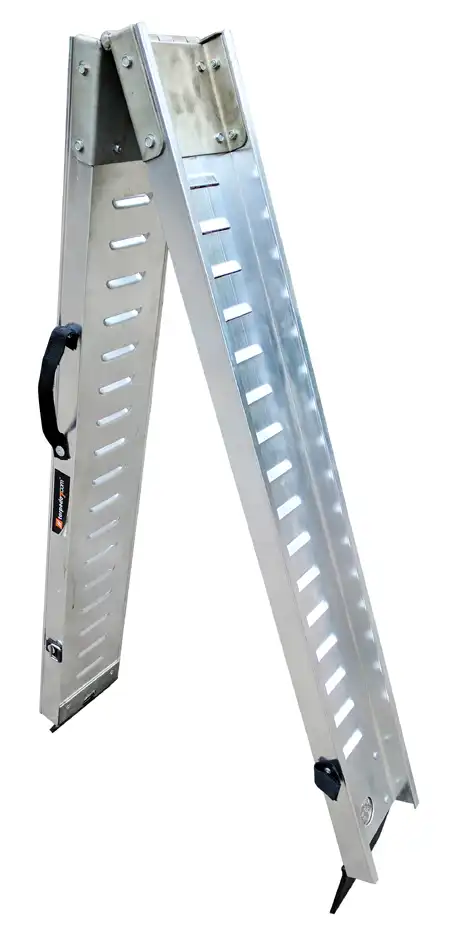Understanding Moto Ramp Safety Features and Regulations
Essential Safety Features of Motorcycle Loading Ramps
When it comes to motorcycle transport, safety is paramount. High-quality motorcycle ramps are engineered with several crucial features to ensure secure loading and unloading. These include robust construction materials, typically aircraft-grade aluminum, which provide excellent strength-to-weight ratios. The ramp surface often incorporates serrated or perforated designs to enhance traction, even in wet conditions. Additionally, many ramps feature side rails or raised edges to prevent accidental slippage during use.
Global Regulations Governing Motorcycle Ramp Standards
Motorcycle ramp manufacturers must navigate a complex landscape of international regulations to ensure their products meet global safety standards. In the United States, the Occupational Safety and Health Administration (OSHA) provides guidelines for ramp safety in workplace settings. The European Union has its own set of standards outlined in the Machinery Directive, which covers the safety of loading ramps. Other regions, such as Australia and Japan, have similar regulatory bodies overseeing ramp safety standards. Compliance with these varied regulations is essential for manufacturers aiming to distribute their products globally.
Importance of Certification and Testing for Moto Ramps
To verify compliance with safety standards, motorcycle ramps undergo rigorous testing and certification processes. These evaluations assess factors such as load-bearing capacity, durability under various environmental conditions, and resistance to wear and tear. Reputable manufacturers often seek third-party certifications to demonstrate their commitment to safety and quality. Such certifications not only provide peace of mind to users but also facilitate easier entry into international markets by meeting pre-established safety criteria.
Design Considerations for Compliant Motorcycle Loading Ramps
Material Selection and Its Impact on Safety
The choice of materials plays a pivotal role in the safety and performance of motorcycle ramps. Aluminum alloys are widely favored for their excellent strength-to-weight ratio, corrosion resistance, and durability. Some manufacturers opt for reinforced polymers or composite materials to achieve specific performance characteristics. The material selection process must consider factors such as load capacity, environmental resistance, and longevity to ensure the ramp meets global safety standards throughout its lifecycle.
Ergonomic Design for User-Friendly Operation
An often-overlooked aspect of motorcycle loading ramp safety is ergonomic design. User-friendly features can significantly reduce the risk of accidents during loading and unloading processes. Foldable motorcycle loading ramps allow for easy storage and transport, while adjustable widths accommodate various motorcycle sizes. Some advanced motorcycle loading ramps incorporate hydraulic or pneumatic assist mechanisms to reduce the physical effort required for deployment. These ergonomic considerations not only enhance safety but also improve overall user satisfaction and compliance with workplace safety regulations.
Innovative Safety Mechanisms in Modern Moto Ramps
As technology advances, so do the safety features incorporated into motorcycle ramps. Some cutting-edge designs include built-in locking mechanisms to prevent accidental folding during use. Others feature integrated weight distribution systems to ensure optimal stability across various vehicle types. Smart ramps equipped with sensors can provide real-time feedback on load distribution and ramp angle, further enhancing safety during the loading process. These innovations demonstrate the industry's commitment to continually improving safety standards in response to evolving global requirements.
Ensuring Compliance in International Motorcycle Transport
Navigating Customs and Regulatory Requirements
International motorcycle transport involves navigating a complex web of customs regulations and safety standards. Exporters and importers must ensure that their motorcycle ramps comply with the specific requirements of each country they operate in. This often involves obtaining proper documentation, such as certificates of conformity or safety declarations. Some regions may require additional testing or inspections upon entry. Staying informed about these varying requirements and maintaining thorough documentation is crucial for smooth international operations and avoiding costly delays or penalties.
Best Practices for Secure Motorcycle Loading Across Borders
Adhering to best practices for motorcycle loading is essential when transporting across international borders. This includes proper ramp placement, ensuring the correct angle of incline, and using appropriate tie-down methods. Many global transport companies develop standardized procedures that comply with international safety norms. These procedures often include pre-loading inspections, step-by-step loading protocols, and post-loading checks to ensure the motorcycle is securely fastened for transit. By implementing these best practices, companies can minimize the risk of damage or accidents during international transport.
Training and Certification for Global Transport Personnel
To maintain consistent safety standards across different regions, companies involved in international motorcycle transport often implement comprehensive training programs for their personnel. These programs cover proper use of motorcycle ramps, understanding of global safety regulations, and specific procedures for different types of motorcycles and transport vehicles. Some organizations offer certifications for personnel who complete these training programs, ensuring a high level of competence and compliance with international standards. This focus on training and certification helps create a culture of safety that transcends geographical boundaries.
Conclusion
Adhering to moto ramp safety standards for global transport compliance is essential for businesses operating in the international motorcycle market. By prioritizing safety features, staying informed about regulatory requirements, and implementing best practices, companies can ensure smooth operations while minimizing risks. As the industry continues to evolve, ongoing education and adaptation to new safety innovations will be crucial. Ultimately, compliance with these standards not only protects valuable cargo but also contributes to a safer, more efficient global motorcycle transport ecosystem.
Contact Us
For more information about our high-quality, compliant motorcycle ramps and loading solutions, please contact us at info@runva.com.cn. Our team of experts is ready to assist you in meeting your global transport needs safely and efficiently.

_1737625693698.webp)


